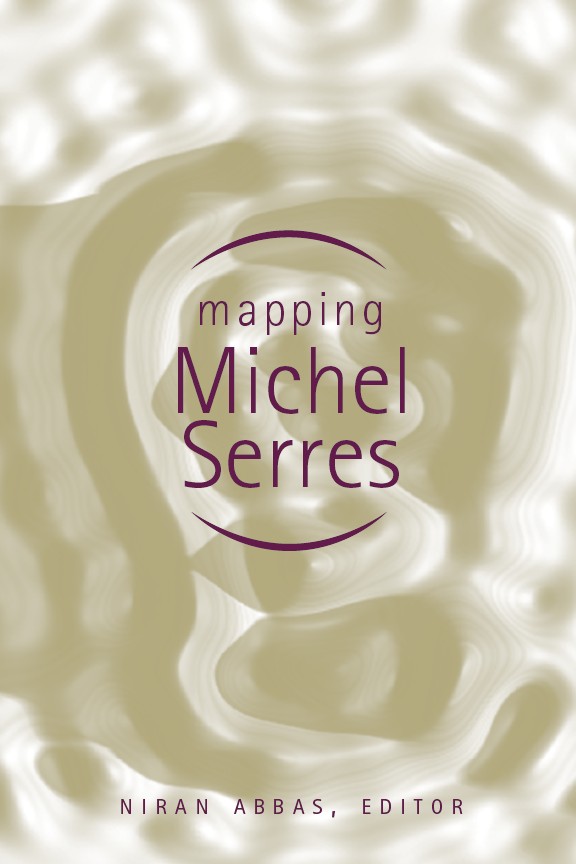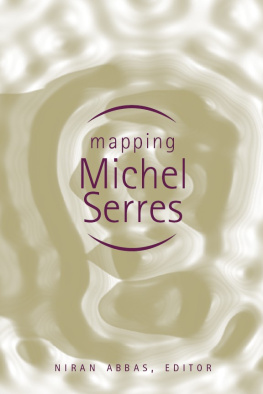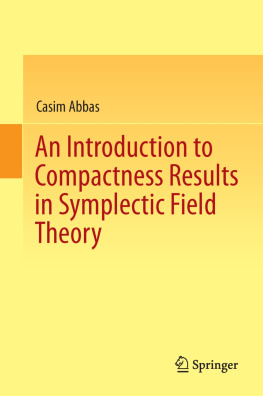Abbas Niran B. - Mapping Michel Serres
Here you can read online Abbas Niran B. - Mapping Michel Serres full text of the book (entire story) in english for free. Download pdf and epub, get meaning, cover and reviews about this ebook. City: Ann Arbor;Mich, year: 2008, publisher: University of Michigan Press, genre: Romance novel. Description of the work, (preface) as well as reviews are available. Best literature library LitArk.com created for fans of good reading and offers a wide selection of genres:
Romance novel
Science fiction
Adventure
Detective
Science
History
Home and family
Prose
Art
Politics
Computer
Non-fiction
Religion
Business
Children
Humor
Choose a favorite category and find really read worthwhile books. Enjoy immersion in the world of imagination, feel the emotions of the characters or learn something new for yourself, make an fascinating discovery.
- Book:Mapping Michel Serres
- Author:
- Publisher:University of Michigan Press
- Genre:
- Year:2008
- City:Ann Arbor;Mich
- Rating:4 / 5
- Favourites:Add to favourites
- Your mark:
- 80
- 1
- 2
- 3
- 4
- 5
Mapping Michel Serres: summary, description and annotation
We offer to read an annotation, description, summary or preface (depends on what the author of the book "Mapping Michel Serres" wrote himself). If you haven't found the necessary information about the book — write in the comments, we will try to find it.
Mapping Michel Serres — read online for free the complete book (whole text) full work
Below is the text of the book, divided by pages. System saving the place of the last page read, allows you to conveniently read the book "Mapping Michel Serres" online for free, without having to search again every time where you left off. Put a bookmark, and you can go to the page where you finished reading at any time.
Font size:
Interval:
Bookmark:

Michel Serres
Edited by Niran Abbas
THE UNIVERSITY OF MICHIGAN PRESS
Ann Arbor
Copyright by the University of Michigan 2005
All rights reserved
Published in the United States of America by
The University of Michigan Press
Manufactured in the United States of America Printed on acid-free paper
Printed on acid-free paper
2008 2007 2006 2005 4 3 2 1
No part of this publication may be reproduced,
stored in a retrieval system, or transmitted in any form
or by any means, electronic, mechanical, or otherwise,
without the written permission of the publisher.
A CIP catalog record for this book is available from the British Library.
Library of Congress Cataloging-in-Publication Data
Mapping Michel Serres / edited by Niran Abbas.
p. cm.
Includes index.
ISBN 0-472-11438-7 (cloth : alk. paper)ISBN 0-472-03059-0
(pbk. : alk. paper)
1. SciencePhilosophy. 2. Serres, Michel.
I. Abbas, Niran, 1969 II. Title.
Q175.M347 2005
501dc22 2004020270
ISBN13 978-0-472-11438-2 (cloth)
ISBN13 978-0-472-03059-0 (paper)
ISBN13 978-0-472-02496-4 (electronic)
First and foremost I would like to thank Steven Connor for his expertise and invaluable help on this project and for his idea for the conference on Michel Serres from which many of the essays in this volume originated. Thanks also to Ana Parejo Vadillo for co-organizing the event.
I would like to thank all the contributors for their support and enthusiasm. Special thanks to Marcel Hnaff, Ren Girard, and Marjorie Perloff and to their publishers for allowing me to reprint their essays in this collection: Of Stones, Angels, and Humans: Michel Serres and the Global City, by Marcel Hnaff, SubStance 83, Vol. 26, No. 2. 1997. Reprinted by permission of the University of Wisconsin Press. From Ritual to Science, by Ren Girard. Configurations 8:2 (2000), 17185. The Johns Hopkins University Press and Society for Literature and Science. Reprinted with permission of The Johns Hopkins University Press. Multiple Pleats: Some Applications of Michel Serres's Poetics, by Marjorie Perloff. Configurations 8:2 (2000), 187200. The Johns Hopkins University Press and Society for Literature and Science. Reprinted with permission of The Johns Hopkins University Press.
Thanks go to LeAnn Fields, Allison Liefer, Marcia LaBrenz, and the editorial team at the University of Michigan Press. And finally I would like to thank my friends and family for their encouragement and support.
A Atlas. Paris ditions Juillard, 1994.
AM Angels: A Modern Myth. Trans. Francis Cowper. Paris: Flammarion, 1994.
B The Birth of Physics. Ed. David Webb. Trans. Jack Hawkes. Manchester: Clinamen Press, 2000.
C With Bruno Latour. Conversations on Science, Culture, and Time. Trans. Roxanne Lapidus. Ann Arbor: University of Michigan Press, 1995.
CS Les Cinq Sens. Paris: Grasset et Fasquelle, 1985.
E claircissements: Entretiens avec Bruno Latour. Paris: ditions Franois Bourin, 1992.
EF Eloge de la philosophie en langue franaise, Paris: Fayard, 1996.
G Genesis. Trans. Genevive James and James Nielson. Ann Arbor: University of Michigan Press, 1995.
H Hermes: Literature, Science, Philosophy. Ed. Josu V. Harari and David Bell. Baltimore: Johns Hopkins University Press, 1982.
J Jouvences sur Jules Verne. Paris: Minuit, 1974.
LC Herms I: La Communication. Paris: Minuit, 1969.
LD Herms IV: La Distribution. Paris: Minuit, 1977.
LH L'Hermaphrodite: Sarrasine sculpteur. Paris: Flammarion, 1987.
LI Herms II: L'Interfrence. Paris: Minuit, 1972.
LT Herms III: La Traduction. Paris: Minuit, 1974.
N La Naissance de la physique dans le texte de Lucrce: Fleuves et turbulences. Paris: Minuit, 1977.
NC The Natural Contract. Trans. Elizabeth MacArthur and William Paul-son. Ann Arbor: University of Michigan Press, 1995.
P The Parasite. Trans. Lawrence R. Schehr. Baltimore: Johns Hopkins University Press, 1982.
R Rome: Le livre des fondations. Paris: Grasset, 1983.
TK The Troubadour of Knowledge. Trans. Sheila Faria Glaser with William Paulson. Ann Arbor: University of Michigan Press, 1997.
Z Feux et signaux de brume: Zola. Paris: Grasset, 1975.
NIRAN ABBAS
When one looks at a certain object only as representing another, the idea one has of it is a sign.
Antoine Arnauld, Logique de Port-Royal, 1872
To map is to take the measure of a world in such a way that the measure may be communicated between people, places, or times. The measure of mapping is not restricted to the mathematical; it may equally be spiritual, political, or moral. Acts of mapping are creative, sometimes anxious, moments in coming to knowledge of the world, and the map is both the spatial embodiment of knowledge and a stimulus to further cognitive engagements. This is how I read the philosopher and writer Michel Serres, as a nomadic, exploratory mapmaker and storyteller who engages with what remains hidden. Mapping is neither secondary nor representational, but doubly operative: digging, finding, and exposing on the one hand, and relating, connecting, and structuring on the other. For Michel Serres, the philosopher's role is not to develop an ontology or epistemology. Knowledge is not about something; rather it is how ideas and concepts interact.
The surface of the map functions like an operating table, a staging ground or a theater of operations upon which the mapper collects, combines, connects, marks, masks, relates, and generally explores. The analogous-abstract character of the map surface means that it is doubly projective; it both captures the projected elements off the ground and projects back a variety of effects through use.
The essays in this book embrace the concept of mapping as an active agent in Serres's work. The contributors underline the various processes and effects of what mapping means, but also what mapping does. The concept of mapping's most productive effects provide a finding that is also a
This quasi-object that is a marker of the subject is an astonishing constructer of intersubjectivity. We know, through it, how and when we are subjects and when and how we are no longer subjects. We: what does that we mean? We are precisely the fluctuating moving back and forth of the I. The I in the game is a token exchanged. And this passing, this network of passes, these vicariances of subjects weave the collection. (P, 227)
As Steven D. Brown points out, We become subjects through the way in which we are caught up in the circulation of that which will make us it the moving back and forth of the I. Humans, Serres claims, are distinctive because they make things into objects that act as stabilizers of social relations (e.g., the plate stabilizes eating arrangements, the weapon formalizes conflict). We owe our present sociality to this invention of the object:
Our relationships, social bonds, would be as airy as clouds were there only contracts between subjects. In fact, the object, specific to Hominidae, stabilizes our relationships, it slows down the time of our revolutions. For an unstable bond of baboons, social changes are flaring up every minute. One could characterize their history as unbound, insanely so. The object makes our history slow. (
Font size:
Interval:
Bookmark:
Similar books «Mapping Michel Serres»
Look at similar books to Mapping Michel Serres. We have selected literature similar in name and meaning in the hope of providing readers with more options to find new, interesting, not yet read works.
Discussion, reviews of the book Mapping Michel Serres and just readers' own opinions. Leave your comments, write what you think about the work, its meaning or the main characters. Specify what exactly you liked and what you didn't like, and why you think so.











